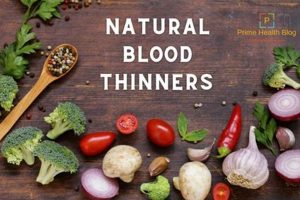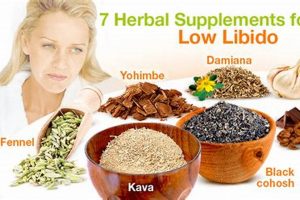Botanical substances marketed to assist in the management of blood glucose levels are the focus. These products, often available over-the-counter, are derived from plants and are intended to be used as adjuncts to conventional medical treatments or lifestyle modifications. An example would be formulations containing berberine, cinnamon, or bitter melon, purported to have hypoglycemic effects.
The use of natural products to support healthy glucose metabolism is rooted in traditional medicine practices across various cultures. For individuals seeking alternative or complementary approaches, these plant-based options represent a potential avenue for maintaining well-being. However, it is crucial to acknowledge that the efficacy and safety profiles of such substances vary and require rigorous scientific evaluation. The appeal lies in the potential for a more holistic approach to health management.
The subsequent sections will delve into specific categories of botanicals used to influence blood sugar, examine the scientific evidence supporting their use, and discuss the potential risks and benefits associated with their consumption. Further consideration will be given to the importance of consulting healthcare professionals before incorporating these substances into a treatment regimen.
Guidance on Utilizing Botanical Agents for Blood Glucose Modulation
The following recommendations are intended to provide information regarding the potential integration of plant-derived substances into blood glucose management strategies. These suggestions are not substitutes for professional medical advice.
Tip 1: Prioritize Consultation with a Healthcare Professional: Before initiating the use of any botanical agent intended to influence blood glucose, a comprehensive discussion with a qualified physician, endocrinologist, or registered dietitian is essential. This ensures that the chosen supplement does not interact adversely with existing medications or underlying health conditions.
Tip 2: Scrutinize Product Quality and Purity: Rigorous evaluation of product labels and sourcing information is crucial. Third-party certifications (e.g., USP, NSF International) can provide assurance regarding the product’s content, purity, and adherence to manufacturing standards. Select reputable brands with transparent sourcing practices.
Tip 3: Initiate Use with Conservative Dosages: To mitigate potential adverse effects, commencement with the lowest recommended dosage is advisable. Gradual incrementation of the dosage, if deemed necessary and safe by a healthcare provider, allows for careful monitoring of individual responses.
Tip 4: Implement Consistent Blood Glucose Monitoring: Regular self-monitoring of blood glucose levels is paramount when incorporating any novel substance into a diabetes management plan. This practice facilitates the identification of trends and the assessment of the supplement’s impact on glycemic control.
Tip 5: Recognize Potential Interactions with Conventional Medications: Many plant-derived compounds possess the capacity to interact with pharmaceutical agents commonly prescribed for diabetes management. Awareness of these potential interactions is critical to avoid synergistic or antagonistic effects. For instance, berberine may amplify the effects of metformin, leading to hypoglycemia in susceptible individuals.
Tip 6: Maintain Realistic Expectations Regarding Efficacy: Botanical agents should not be regarded as replacements for established medical therapies. Their role is best considered as adjunct support within a comprehensive diabetes management strategy that includes dietary modifications, regular physical activity, and, when necessary, pharmacological interventions.
Tip 7: Report Adverse Effects Promptly: Should any untoward symptoms arise during the use of these substances, immediate discontinuation and notification of a healthcare provider are imperative. Adverse effects may manifest as gastrointestinal distress, skin reactions, or unexpected alterations in blood glucose levels.
Adherence to these guidelines, in conjunction with consistent communication with healthcare providers, can facilitate a more informed and responsible approach to the integration of plant-derived substances in efforts to modulate blood glucose. The ultimate objective is the safe and effective management of diabetes and the optimization of overall health.
The concluding section will summarize the key points and offer concluding thoughts on the topic.
1. Efficacy and Safety
The simultaneous consideration of efficacy and safety is paramount when evaluating botanical agents intended to modulate blood glucose. Efficacy, in this context, refers to the demonstrated ability of a substance to measurably reduce blood sugar levels. Safety encompasses the absence of significant adverse effects or harmful interactions with other medications. An imbalance, wherein a supplement demonstrates efficacy without adequate safety data, or vice versa, renders its use questionable.
Real-world examples underscore this point. Berberine, an isoquinoline alkaloid found in several plants, has shown promise in lowering HbA1c levels in some clinical trials. However, concerns exist regarding its gastrointestinal side effects and potential interactions with drugs metabolized by the cytochrome P450 enzyme system. Similarly, cinnamon, often touted for its antidiabetic properties, contains coumarin, a compound with known hepatotoxic effects at high doses. The assessment of safety requires long-term studies, which are often lacking for many herbal supplements. This is essential to identify rare but serious adverse events that may not be apparent in short-term investigations.
In conclusion, the responsible use of botanical agents for blood glucose management demands a rigorous assessment of both efficacy and safety. The presence of one without the other is insufficient justification for widespread adoption. Further high-quality research is necessary to elucidate the benefits and risks associated with these substances, ensuring that individuals can make informed decisions about their use under the guidance of qualified healthcare professionals. The absence of robust evidence necessitates a cautious approach, prioritizing patient safety above all else.
2. Dosage Considerations
The efficacy and safety profile of any botanical agent purported to lower blood sugar are inextricably linked to dosage. Insufficient quantities may render the supplement ineffective, while excessive amounts can precipitate adverse effects, potentially exacerbating the very condition the individual seeks to manage. The therapeutic window, the range between the minimum effective dose and the maximum safe dose, varies considerably among different herbs and individual patients. Therefore, a standardized, one-size-fits-all approach to dosage is fundamentally inappropriate.
For example, while cinnamon has demonstrated some hypoglycemic effects in clinical studies, effective dosages range widely, and exceeding recommended amounts can lead to elevated levels of coumarin, posing a risk of liver toxicity. Similarly, berberine, another frequently discussed supplement, exhibits a narrow therapeutic window; dosages too low may not significantly impact blood glucose, while excessive intake can cause gastrointestinal distress. Factors such as age, weight, kidney function, liver function, and concurrent medication use all influence the appropriate dosage. Consequently, individual titration, guided by a healthcare professional and supported by regular blood glucose monitoring, is essential. The consequences of neglecting proper dosage considerations can range from therapeutic failure to serious health complications.
In summation, informed decision-making regarding botanical supplements for blood sugar modulation necessitates a thorough understanding of dosage considerations. The potential benefits are contingent upon using appropriate quantities, carefully tailored to the individual patient, and consistently monitored. Ignoring this crucial aspect not only diminishes the likelihood of achieving the desired therapeutic outcome but also elevates the risk of adverse events. This highlights the indispensable role of medical supervision in any regimen involving these substances.
3. Herb-Drug Interactions
The simultaneous use of botanical supplements intended to lower blood sugar and conventional pharmaceutical agents presents a significant risk of herb-drug interactions. These interactions occur when components within the herbal supplement affect the absorption, distribution, metabolism, or excretion of prescription medications, leading to altered drug concentrations and potentially harmful clinical outcomes. This complex interplay can either diminish the efficacy of the prescribed drug or, conversely, amplify its effects, increasing the risk of adverse events. For instance, certain herbal products with hypoglycemic properties, when co-administered with insulin or oral antidiabetic drugs, may potentiate the risk of hypoglycemia, resulting in dangerously low blood glucose levels.
Several mechanisms contribute to these interactions. Some herbs can inhibit or induce cytochrome P450 enzymes, which are responsible for metabolizing a wide range of drugs in the liver. This alteration in enzyme activity can lead to either reduced drug levels (if the enzyme is induced, accelerating drug breakdown) or elevated drug levels (if the enzyme is inhibited, slowing drug breakdown). Furthermore, some herbal supplements can affect drug transporters, influencing the movement of drugs into and out of cells. For example, St. John’s Wort, although not typically used for blood sugar control, is a known inducer of CYP3A4, potentially reducing the effectiveness of numerous medications, including certain antidiabetic agents. The practical significance of understanding herb-drug interactions lies in preventing adverse drug events, optimizing medication effectiveness, and ensuring patient safety.
In summary, the potential for interactions between herbal supplements marketed to lower blood sugar and conventional medications is a serious concern that demands careful consideration. Healthcare providers must actively inquire about patients’ use of herbal products and possess a thorough understanding of potential interactions to mitigate risks. Patients considering the use of such supplements should be thoroughly educated about the risks of interactions and the importance of ongoing communication with their healthcare team. Robust research is needed to fully characterize the interaction potential of commonly used herbal supplements and develop strategies to minimize adverse outcomes. The safe and effective management of blood sugar requires an integrated approach that considers both conventional and complementary therapies while prioritizing patient safety.
4. Quality Control
Quality control is a critical determinant of the safety and efficacy of botanical supplements marketed to lower blood sugar. Variations in the cultivation, harvesting, processing, and manufacturing practices of these supplements can significantly influence their chemical composition, potency, and presence of contaminants. Poor quality control can result in products that contain inconsistent levels of active ingredients, are adulterated with undeclared substances, or are contaminated with heavy metals, pesticides, or microorganisms. Consequently, individuals consuming these substandard products may experience therapeutic failure, adverse health effects, or interactions with conventional medications. The absence of stringent quality control standards undermines the potential benefits of these supplements and poses a tangible risk to public health. For instance, a study analyzing several commercially available cinnamon supplements revealed significant variations in coumarin content, with some products exceeding safe daily intake levels, potentially leading to liver damage.
The implementation of robust quality control measures encompasses several key elements. Firstly, proper identification and authentication of the plant material are essential to prevent substitution or adulteration with related species. Secondly, standardized extraction and processing methods are necessary to ensure consistent levels of active compounds in the final product. Thirdly, rigorous testing for contaminants, including heavy metals, pesticides, and microbial pathogens, is crucial to guarantee product safety. Fourthly, adherence to Good Manufacturing Practices (GMP) is vital throughout the manufacturing process to minimize the risk of contamination and ensure product consistency. Finally, third-party certifications from organizations such as USP, NSF International, or ConsumerLab.com can provide independent verification of product quality and purity. These certifications offer consumers an additional layer of assurance, but they are not a substitute for due diligence and informed decision-making.
In summary, quality control is an indispensable component of the safety and efficacy of herbal supplements intended to lower blood sugar. The lack of stringent quality control can lead to inconsistent product quality, contamination, and potential harm to consumers. Healthcare professionals and individuals considering the use of these supplements should prioritize products from reputable manufacturers that adhere to GMP and undergo third-party testing. While these measures cannot eliminate all risks, they significantly enhance the likelihood of obtaining a safe and effective product. Ongoing research is needed to develop and refine quality control standards for herbal supplements, ensuring that consumers have access to reliable and trustworthy products. The practical significance of this understanding lies in promoting the responsible use of these substances and protecting public health.
5. Individual Variability
The interaction between herbal supplements intended to lower blood sugar and individual physiology is characterized by significant variability. This variability stems from a multitude of factors, including genetic predispositions, metabolic rates, the presence of comorbidities, and the concurrent use of pharmaceutical agents. Consequently, the same herbal intervention may elicit disparate responses across different individuals, ranging from significant glycemic improvement to negligible effects or even adverse reactions. This observation underscores the imperative for personalized approaches when considering the use of botanical agents for blood sugar management. For example, two individuals with similar diagnoses of type 2 diabetes, body mass indices, and ages may exhibit markedly different responses to berberine, with one experiencing a substantial reduction in HbA1c while the other shows no discernible change. This divergence highlights the influence of underlying genetic variations affecting drug metabolism and receptor sensitivity.
The consideration of individual variability necessitates a nuanced understanding of both the pharmacokinetic and pharmacodynamic properties of herbal supplements. Pharmacokinetics describes how the body processes a substance, including its absorption, distribution, metabolism, and excretion. Variations in these processes, influenced by factors such as liver and kidney function, can significantly alter the bioavailability of active compounds within the herbal supplement. Pharmacodynamics, on the other hand, refers to how the substance affects the body, including its interaction with cellular receptors and its impact on metabolic pathways. Individual differences in receptor sensitivity and metabolic enzyme activity can modulate the magnitude and duration of the supplement’s effects. A practical application of this understanding involves utilizing pharmacogenomic testing, where available, to identify genetic variations that may predict an individual’s response to specific herbal supplements. Such testing can inform treatment decisions and minimize the risk of adverse events.
In summary, individual variability represents a critical factor in the effectiveness and safety of herbal supplements intended to lower blood sugar. The complex interplay of genetic, metabolic, and environmental factors necessitates a personalized approach to treatment, guided by careful assessment and monitoring. While some individuals may derive benefit from these supplements, others may experience negligible effects or adverse reactions. A comprehensive understanding of individual variability, coupled with a commitment to evidence-based practices, is essential to ensure that herbal supplements are used responsibly and effectively. Challenges remain in fully elucidating the mechanisms underlying these individual differences and developing predictive models to guide treatment decisions. However, ongoing research and clinical experience continue to enhance our understanding of this complex relationship, ultimately improving patient outcomes.
Frequently Asked Questions
The following section addresses common inquiries regarding the use of plant-derived substances to influence blood glucose levels. The information provided is for educational purposes and should not substitute professional medical advice.
Question 1: Are herbal supplements a substitute for conventional diabetes medications?
Herbal supplements are not intended as replacements for prescribed medications. Individuals diagnosed with diabetes should adhere to their physician’s treatment plan, which may include lifestyle modifications, oral medications, or insulin therapy. Botanical agents may be considered as adjuncts, but only under the guidance of a qualified healthcare professional.
Question 2: How quickly can herbal supplements lower blood sugar?
The onset of action varies depending on the specific herbal supplement, the dosage, and individual factors. Some supplements may exhibit a gradual effect over several weeks, while others may produce more immediate, albeit modest, changes. Regular blood glucose monitoring is essential to assess the impact of any supplement on glycemic control.
Question 3: Are there any specific herbal supplements that are proven to lower blood sugar?
While certain herbal supplements, such as berberine, cinnamon, and bitter melon, have demonstrated potential benefits in clinical studies, the evidence remains limited and inconsistent. The quality of available research varies, and more rigorous studies are needed to confirm their efficacy. It is crucial to recognize that individual responses to these supplements may vary significantly.
Question 4: What are the potential side effects of herbal supplements used to lower blood sugar?
Herbal supplements can cause a range of side effects, including gastrointestinal distress, allergic reactions, and interactions with conventional medications. Some supplements may also possess hepatotoxic or nephrotoxic properties. It is essential to research potential side effects thoroughly and consult with a healthcare professional before initiating use.
Question 5: How can one ensure the quality and purity of herbal supplements?
Select products from reputable manufacturers that adhere to Good Manufacturing Practices (GMP) and undergo third-party testing. Look for certifications from organizations such as USP, NSF International, or ConsumerLab.com, which provide independent verification of product quality and purity. Scrutinize product labels for detailed ingredient lists and sourcing information.
Question 6: What should one do if experiencing adverse effects while taking herbal supplements?
Immediately discontinue use and notify a healthcare provider. Adverse effects may manifest as gastrointestinal distress, skin rashes, or unexpected changes in blood glucose levels. Prompt medical attention is essential to manage any adverse reactions and prevent further complications.
The careful evaluation of potential risks and benefits, coupled with open communication with healthcare professionals, is essential for the responsible consideration of botanical agents in the context of blood glucose management.
The subsequent section will present concluding remarks on the topic.
Herbal Supplements That Lower Blood Sugar
This exploration of herbal supplements that lower blood sugar has underscored the complexities inherent in their use for glycemic control. The evidence base supporting the efficacy of specific botanicals remains inconsistent, and significant concerns persist regarding quality control, potential herb-drug interactions, and individual variability in response. While some individuals may experience modest benefits, the absence of rigorous, large-scale clinical trials necessitates a cautious and evidence-based approach.
The responsible integration of herbal supplements into a diabetes management plan requires careful consideration of potential risks and benefits, alongside open communication with healthcare professionals. Further research is essential to elucidate the mechanisms of action of these substances, identify reliable biomarkers for predicting individual responses, and establish standardized quality control measures. Until such data become available, reliance on conventional medical therapies and lifestyle modifications remains paramount for the effective and safe management of diabetes.







